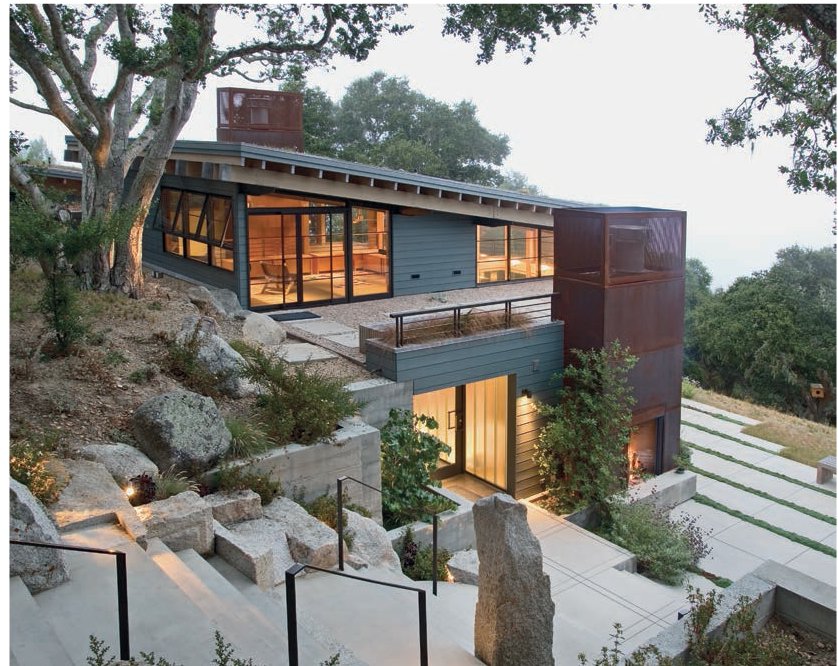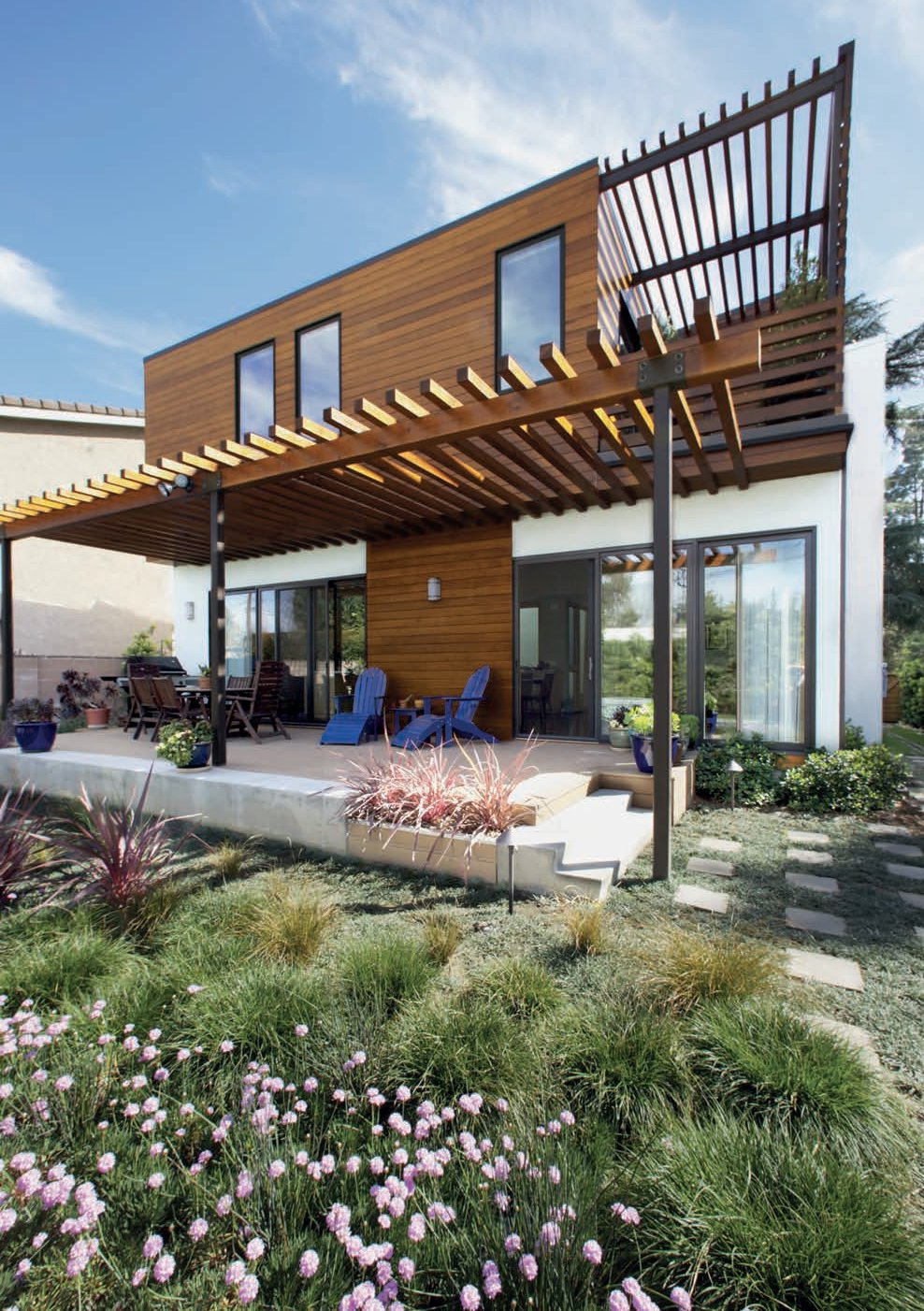Terms such as ‘green’, ‘eco’, ‘living’, ‘planted’ and ‘vegetated’ are used to describe roofs where plants are used to improve performance and appearance (Snodgrass and McIntyre 2010). This age-old concept has been reintroduced using contemporary technologies in order to confront the increasing environmental challenges associated with conventional roofing. At the same time, this type of roofing can provide homeowners with financial benefits (Johnston and Gibson 2010, Friedman 2007). The types and functioning principles of these roofs will outlined below.
It is possible to build green roofs on either flat or pitched roofs. While flat roofs are the most common type, the pitched roof design is also a viable method that has been used for centuries. The common flat roof can incorporate rooftop terraces and gardens, and this version is typically more expensive due to the complex systems and membranes required to waterproof and drain water (Snodgrass and McIntyre 2010). The other version is the simpler and easier to build pitched roof, whose natural slope easily drains of excess rainwater to prevent leakage. This natural drainage enables fewer waterproofing membranes and drainage methods to be used, thereby decreasing the cost of materials and labour (Mauritius EcoBuilding 2008). While typical slopes for pitched roofs are less than 20 degrees, some companies advertise roofs with up to 45-degree slopes (Kwok and Grondzik 2007, FlorDepot 2011a and 2011b). With higher pitch models, it is important to use supports to prevent soil slippage and erosion: pre-cultivated, modular, synthetic lattice vegetation mats, horizontal strapping, battens and grids such as hexagonal lattice are all quickly overgrown by the vegetation (FlorDepot 2011b, GRHC 2009).
In addition to selecting the structure, it is also important to determine its ‘intensity’, or the thickness and size of the vegetation and the protective layers. This varies greatly according to the desired type of use. Those who want minimal vegetation and do not intend to walk on it can use extensive roofs, which are the most affordable. In contrast, homeowners who wish to have outdoor roof terraces, edible landscaping and trees are advised to select the intensive or the semi-intensive types.
Extensive green roofs are simple and lightweight, with little plant diversity and low maintenance requirements. Generally, they do not require any additional structural reinforcement due to the minimal substrate depth, which usually ranges between 50 and 150 mm (2 and 6 in) (Landreville 2005). This type of roof is best covered with indigenous vegetation that is resilient enough to withstand harsh climatic conditions without any human irrigation or maintenance (GreenRoofs 2011). In temperate climates, this form of green roof demonstrates the highest benefit-to-cost ratio and is the most common vegetated roof cover used (Miller 2010).
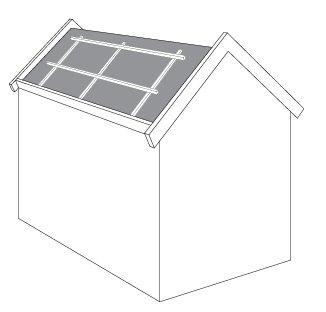
Figure 17.1: Wooden strapping members are introduced on green pitched roofs to prevent the slippage of the growing medium.
The semi-intensive green roof is similar to the extensive, with the only difference being the use of a deeper substrate, 10 to 20 cm (4 to 8 in), to accommodate a larger range of flora (Dunnett and Kingsbury 2008). This thicker vegetation serves to absorb more rainwater, further cool the roof through evapotranspiration and acts as a larger thermal mass to more effectively moderate the temperature in the dwelling (Johnston and Gibson 2008).
An intensive green roof differs greatly from the other systems by also being a garden and a terrace. These roofs typically require additional structural support due to the added weight of both people and the thicker substrate needed for the plants and trees. This substrate typically ranges from 20 to 60 cm (8 to 24 in) in depth and is composed of thicker soils and organic matter for richer growing conditions (Peck and Kuhn 2008). Due to the vegetation, an intensive roof almost always requires irrigation, fertilizing and on-going maintenance to function properly (Peck and Kuhn 2008). It is also important to note that such elevated urban spaces require safety measures such as railings and lighting (Dunnett and Kingsbury 2008).
Regardless of the type selected, to function well, green roofs must be constructed with the proper membranes and vegetation. These components serve to seal off the structure from water and root penetration damage. It is also imperative that these components provide a proper growing environment for plants by incorporating soil beds of suitable size, drainage barriers, irrigation systems and slippage prevention. Once all of these lower layers have been properly considered and constructed, it is important to select the appropriate type of vegetation. This can vary greatly according to the needs of the occupant, local climate and the type of the chosen roof. Once built, homeowners can expect a green roof to last two to three times longer than a conventional one.
While each type of green roof requires different layers and a specific set-up, their general layout and components are similar in principle. A green roof can be constructed over any typical roofing material, such as wood, steel or concrete as long as the roof is structurally designed for the desired garden. Once the structure is set, the first membrane to be laid down is the waterproofing membrane. This membrane is the most important and is typically constructed from a material such as PVC, thermal polyolefin, rubber, polymer modified bituminous sheet membranes, liquid-applied rubberized asphalt or coal tar pitch (Miller 2010). Each material has its unique application – such as spray-on, thermally sealed layers or large rolls – and should be weighed for cost-benefit ratios. After application, it is important to test the effectiveness of the membrane with various techniques, such as intentionally flooding the roof or electric field vector mapping, which charges the moist roofing surface and looks for electrical grounds caused by contact between the moisture layer and the underlying structure (Miller 2010).
•Environmental awareness
•High energy costs
•Advancement in roof insulation technologies
•Urban heat island effect
INNOVATIONS
•Advanced drainage systems
•Highly efficient and cost-effective waterproofing membranes
•Better structural support
For waterproofing membranes that cannot withstand root and biological attack over the course of many years, a root protection barrier layer is required next. This is especially important for organic oil-based materials such as asphalt or bitumen, which can be broken down by roots. Therefore, it is important that designers cross reference the manufacturer recommendations of the materials used with other, regional sources such as the National Roofing Contractors Association or the American Standard Testing Methods to ensure a successful, leak-proof design (Miller 2010, Snodgrass and McIntyre 2010).
Next, it is imperative to implement drainage procedures to avoid roof flooding and subsequent, increased pressure on the waterproofing membrane, as well as potential drowning for the vegetation (Miller 2010). For flat roofs, it is recommended that there be a minimum slope of 2.1 cm per linear meter (0.25 in per linear foot), which leads to surface drains located halfway between structural supports (Snodgrass and McIntyre 2010). These drains and succeeding subsurface pipes, gutters and downspouts should all be cleaned regularly to prevent blockage (BCIT 2009).
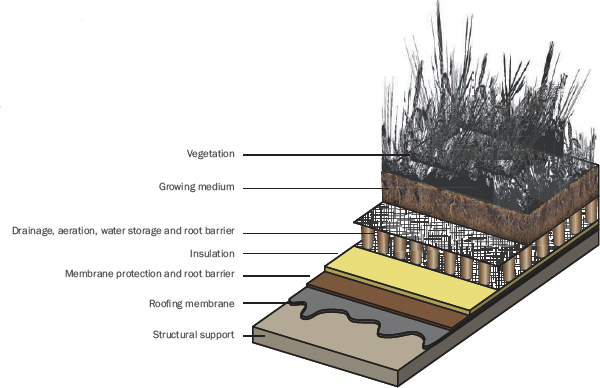
Figure 17.2:Components of an intensive green roof.
Apart from having the correct slope, a green roof also requires a drainage layer to function properly. This usually consists of a layer of course medium – such as gravel – or synthetic sheets, which are not only able to shed water, but also retain some water in small depressions, similar to egg cartons, depending upon the model (Snodgrass and McIntyre 2010). While synthetic sheets are usually more affordable, less labour intensive and more effective at shedding water, there is still some debate as to whether the water-retaining versions are effective. Furthermore, there is also a discussion as to whether plants grow as successfully with it, since gravel offers root support while the synthetic sheets do not (Snodgrass and McIntyre 2010).
After the drainage considerations have been affected, the final layer of substrate or growing medium can be applied. The function of this layer is to absorb water and minerals to provide the best growing conditions for vegetation. The make-up of this layer can range from gravel and sand to thick organic soil depending on the type of roof – extensive, semi-intensive or intensive.
With the appropriate design, green roofs have the potential to offer more advantages than conventional ones. Combined with other concepts such as urban agriculture, green roofs can even be the place where food is grown (Trottier 2008).
17.1 GREEN ROOFS |
|
Project |
House Ocho |
Location |
Carmel, California, USA |
Architect |
Feldman Architecture |
House Ocho, located in a nature reserve in California’s Santa Lucia Mountains, offers a breathtaking downhill view of oak forests and steep meadows. Moreover, the house represents a significant achievement in sustainable design, integrating living space and natural surroundings. Designed by the San Franciscobased firm, Feldman Architecture, in collaboration with the ecological consulting and design firm Rana Creek, House Ocho received an Energy and Sustainability Honour award from the American Institute of Architects in 2007 for its use of green roofs and passive solar heating. In addition, Rana Creek also received the 2007 Award for Excellence: Extensive Roof System awarded by Green Roofs for Healthy Cities.
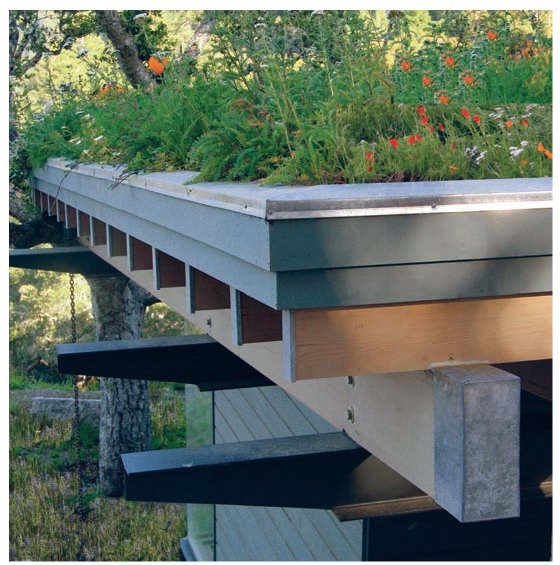
The green roof, which reduced the dwelling’s energy consumption by 30 percent.
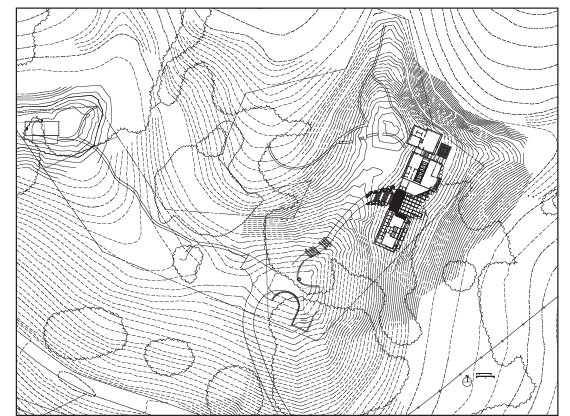
Site plan

The dwelling was conceived of as a series of pavilions.

Elevation showing the green roof on all pavilions.
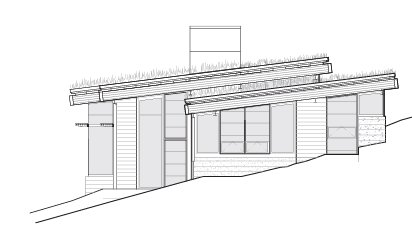
Side elevation of the award-winning dwelling.
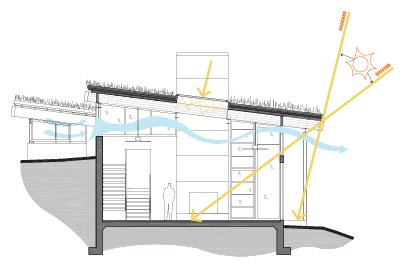
The roof angle and eaves block the summer sun and lets it in during the winter.
The house is set into the ground to minimize sight lines.
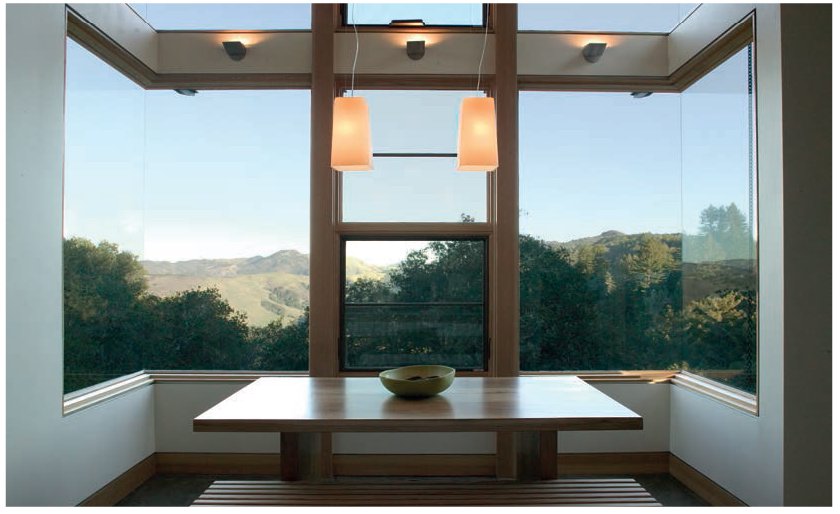
The openness of the design offers a breathtaking view of the forest below.
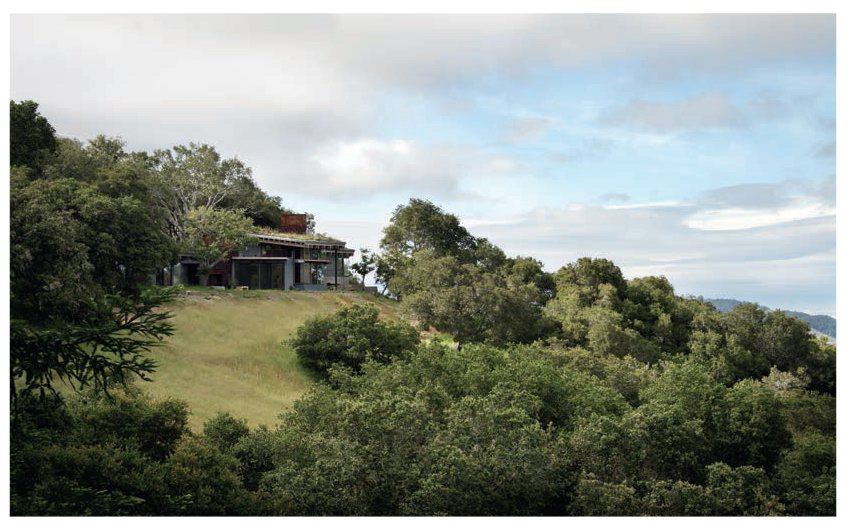
The landscaping around the house includes mostly native plants.
Situated in an area with high seismic activity, the 269 m2 (2,900 sq ft) house is set into the ground, minimizing the sight lines against the surrounding natural reserve, and at the same time protecting the integrity of the structure in case of an earthquake. The architects also decided to divide the dwelling into a series of pavilions to break up its overall mass and further its stability.
The most prominent feature of the house is its 395 m2 (4,250 sq ft) green roof. The growing medium on the roof is 15 cm (6 in) of a lightweight soil mix, used to reduce its weight to accommodate possible seismic activities.
The landscaping around the house and the green roof consist primarily of native plants that thrived on the site prior to construction. There are flowers such as poppies and goldfields, wild berries and, other perennial plants such as Sand Sedge, Point Joe Fescue and yarrow. Rana Creek’s design focused on controlling nonnative species and facilitating the natural regeneration of local plants.
The green roof offers a usable landscape, filters and collects rainwater that minimizes the demand for its maintenance, attenuates sound and helps with thermal insulation. For instance, the homeowner’s energy consumption in the summer months was reduced by 30 per cent due to the green roof. The roof also reduces sound by approximately 43 decibels.
House Ocho is an example of the green roof’s potential in minimizing environmental footprint and in integrating architecture and ecology.
17.2 GREEN ROOFS |
|
Project |
Villa Bio |
Location |
Figueres, Spain |
Architect |
Cloud9/Enric Ruiz-Geli |
With a shape that replicates a sloping hillside forest, Villa Bio is a sustainable and affordable house that blends into the natural surroundings of the town of Figueres, Spain. The hilly green landscape is dominated by traditionally designed Spanish homes; however, in contrast to its neighbours, the design of the Villa Bio is inspired by natural forms and the ways in which landscape transforms and grows.
The Spanish architecture firm, Cloud9 designed the house as a ramping spiral that continuously elevates in parallel with the land’s topography. Spanning across the house, the roof is integrated with one of the main sustainable features, the hydroponic garden. Due to an absence of soil, systematic requirements to prevent soil erosion are unnecessary, and the roof, covered by vegetation becomes more accessible. Furthermore, the sloping roof absorbs the excess runoff and acts as a rainwater collection system. Built without stairs, the ramped green roof was designed to be accessible for people with reduced mobility and to allow the occupants to stroll and rest on the spacious terrace. The house was constructed with poured-in-place concrete and is divided into two halves to create a split-level design. Due to constraints created by the lot, the garage is placed beneath the house. Small openings along the concrete walls and ceilings offer multiple light sources and exterior views, while also protecting the dwellers’ privacy. Without the need for support beams across the entire length of the house, natural light pours into the interior with little obstruction. The 15.2 m (50 ft) wide glass window at the rear end of the house exposes the living space to both views and light. At the front end, the master bedroom is located on the higher half and office spaces in the lower. With both spaces completed with floor-to-ceiling windows, the span from one side to the other becomes apparent.
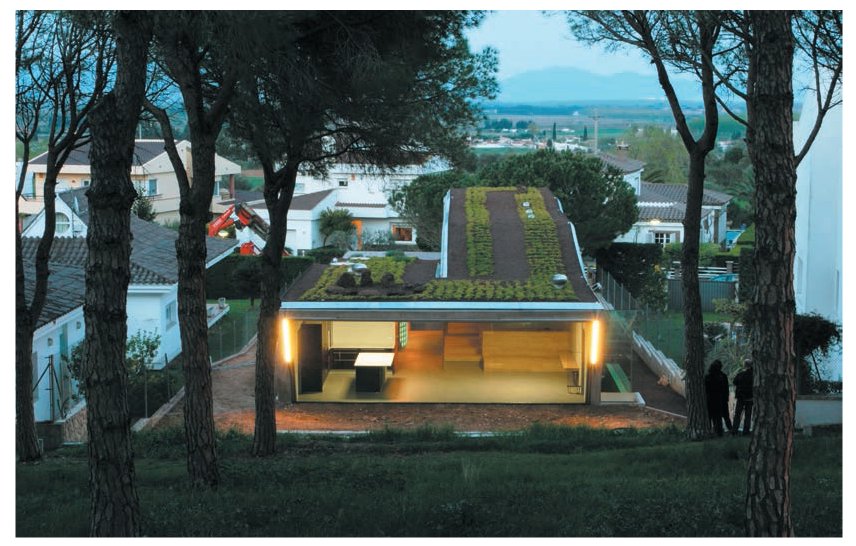
The shape of Villa Bio replicates the sloping hill side. Visible is the green roof.
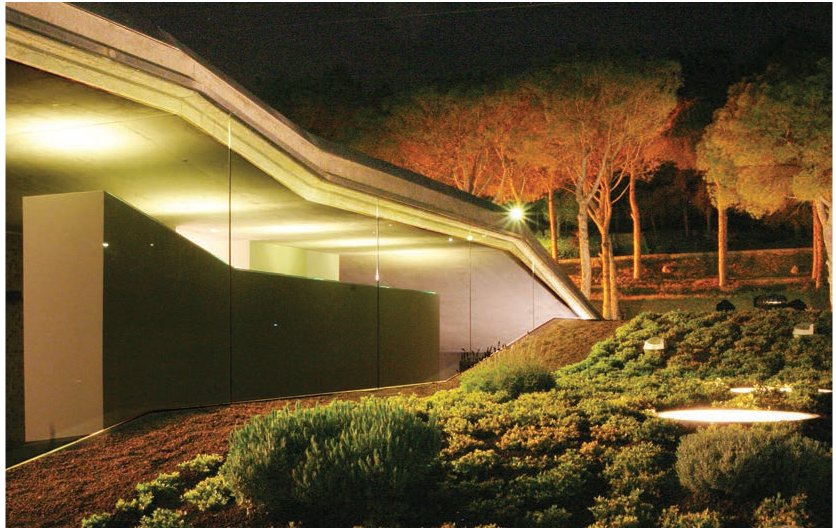
The design of the house was inspired by natural forms.

View of the hallway and stairs.
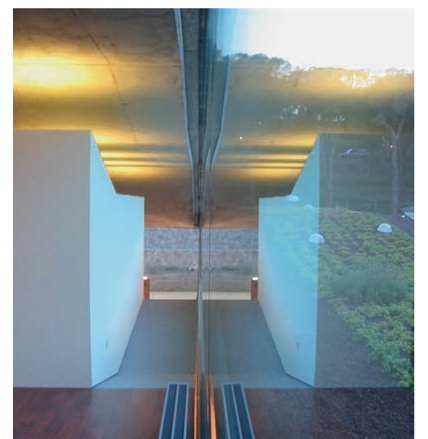
View of the roof garden from the interior.
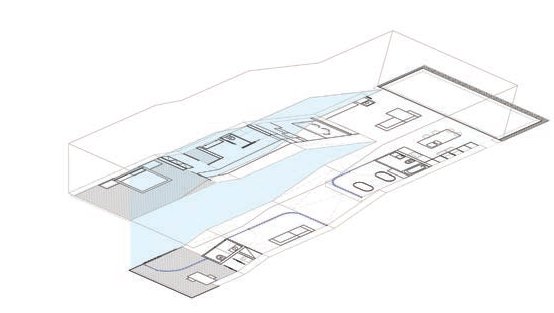
The master bedroom is located on the higher half and the office space in the lower.

The house is divided into two halves to create a split-level design.

The dwelling is constructed with poured-in-place concrete.

Cross section.

The garage is placed beneath the main living area.
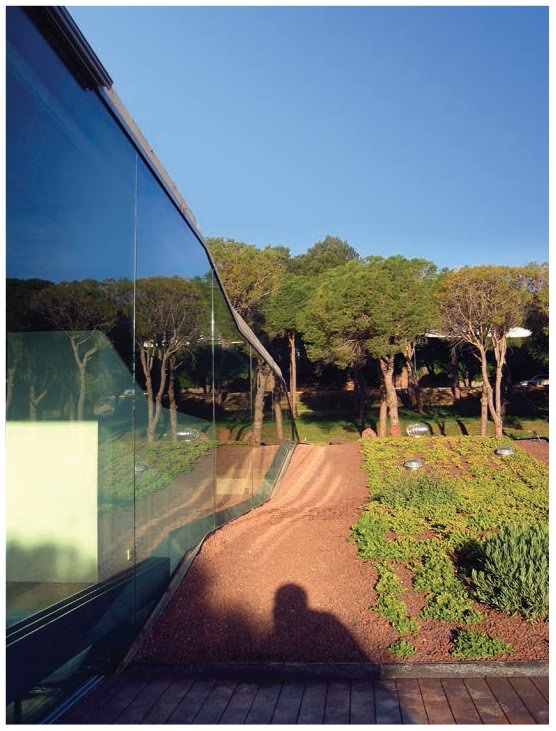
The sloping roof absorbs the excess runoff and acts as a rainwater collection system.

